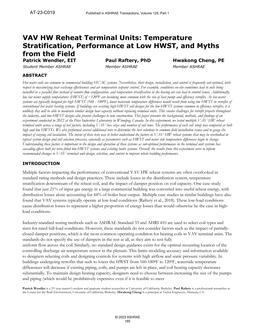
C019 — VAV HW Reheat Terminal Units: Temperature Stratification, Performance at Low HWST, and Myths from the Field
- Comments Off on C019 — VAV HW Reheat Terminal Units: Temperature Stratification, Performance at Low HWST, and Myths from the Field
- ASHRAE
Click here to purchase
Hot water coils are common in commercial building HVAC systems. Nevertheless, their design, installation, and control is frequently sub-optimal, with respect to maximizing heat exchange effectiveness and air temperature setpoint control. For example, conditions on-site sometimes lead to coils being installed in a parallel flow instead of counter flow configuration, and temperature stratification in the leaving air can lead to control issues. Additionally, low hot water supply temperatures (HWST) of ~120°F are becoming more common with the rise of heat pump and efficiency retrofits. As hot water systems are typically designed for high HWST (160 – 180°F), lower waterside temperature differences would result from using low HWST in retrofits of conventional hot water heating systems. If buildings use existing high-HWST coil designs for the low-HWST systems common to efficiency retrofits, it is unlikely they will be able to maintain similar design heat capacity without replacing terminal units. This creates challenges for retrofit projects throughout the industry, and low-HWST designs also present challenges to new construction. This paper presents the background, methods, and findings of an experiment conducted in 2022 at the Price Industries Laboratory in Winnipeg, Canada. In this experiment, we tested multiple VAV HW reheat terminal units across a range of test factors, including VAV box sizes and number of coil rows. The performance of each coil setup was compared at both high and low HWSTs. We also performed several additional tests to determine the best solutions to common field installation issues and to gauge the impact of varying coil insulation. The intent of these tests was to better understand the factors in VAV HW reheat systems that may be overlooked in typical system design and coil selection processes, especially as parameters such as HWST and water side temperature differences begin to change. Understanding these factors is important to the design and operation of these systems as sub-optimal performance in the terminal unit systems has cascading effects both for retro-fitted low-HWST systems and existing boiler systems. Overall, the results from this experiment serve to inform recommended changes to VAV terminal unit design, selection, and control to improve whole-building performance.
Product Details
- Published:
- 2023
- Number of Pages:
- 8
- Units of Measure:
- Dual
- File Size:
- 1 file , 2.4 MB
- Product Code(s):
- D-AT-23-C019
- Note:
- This product is unavailable in Russia, Belarus

